
“If you build it, they will come.”
That statement may have worked a few years ago but certainly not in today’s competitive world of online marketing.
Mind-blowing content is a great start, but there’s more to be done if you want to dominate the SERPs.
For people to discover your website, you need to build pathways and big, flashing signs that lead them there.
In digital marketing terms, this means you need links, links and more links.
After all, links are the pathways that get people to your site from elsewhere on the web. That’s why you find clickable links on every corner of the internet, from blogs to social media posts.
They also give you an edge in SEO (search engine optimization). Search engines will rank the quality of your link pathways to determine how high up your site appears in search results.
The higher you rank in the search results, the more site visitors you’ll see.
What are Backlinks and Why are They Important?
For anyone who’s completely new to the concept of backlinks, we’ll start with the basics.
A backlink is created when one website links to another.
A backlink is sometimes called an inbound link, because it leads readers in to your site, or an external link, because it leads readers to a site that’s external to the one they’re on.
Whatever you call them, backlinks are an important factor in SEO.
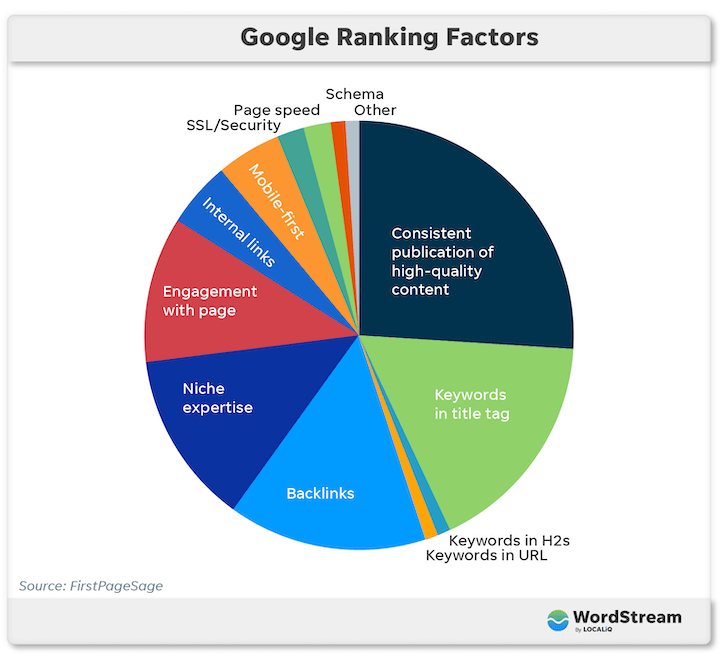
In short, Google sees this link as a vote of confidence. The more quality links a website earns, the higher its perceived quality is.
Now, the important word here is “quality.”
The key is that not all links have the same value. It’s better to earn a few quality backlinks from the right sources than to get thousands of them from spammy link farms.
But what makes a backlink quality or not?
A quality backlink is a dofollow link that is placed within the content on the referring page and has natural anchor text.
Link Relevancy
The source of the link is just as important as the link itself. Gone are the days when you could easily slap backlinks on random websites and call it a day.
Google has gotten smarter.
If you own a blog about hair care, for example, a relevant link is one that comes from a similarly-themed website (hygiene, hair care, beauty) and not one from a totally different niche like gardening.
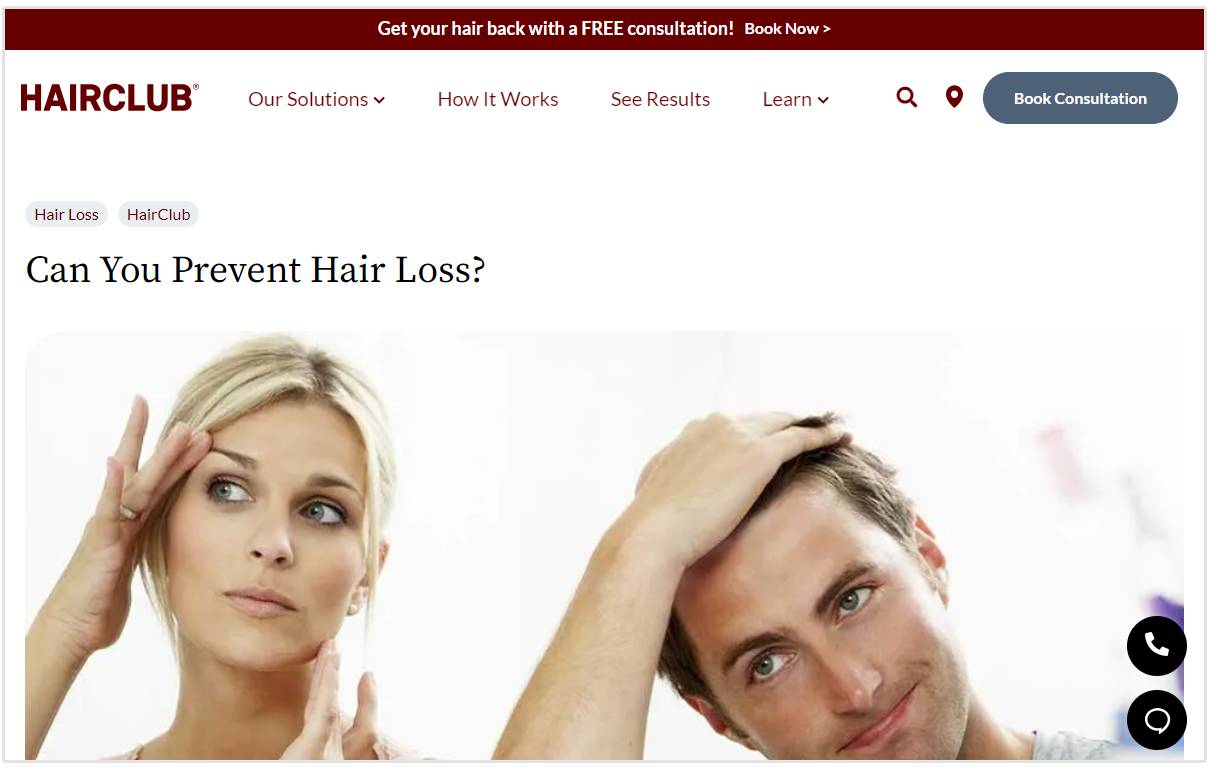
Link relevancy is determined by the anchor text that’s used (more on this later), the content of all the texts surrounding the link and the other external links on the page.
By building relevant links, you’re not only pleasing Google but also improving your sales prospects.
Since the backlink comes from a similar website, people who will be clicking that link are more likely to respond to whatever you’re offering, resulting in lower bounce rates and higher conversions.
Site Authority
As the competition heats up, relevant links are no longer enough. You also need links from high-authority sites, or those deemed by Google as trustworthy by virtue of their content and link profile.
Major news websites like the New York Times, for example, may not be relevant to your site, but their high authority can spill over to your website if you get backlinks from them.
Although it’s not 100% accurate, a site’s Domain Strength score can help you decide whether a link from a website is worth pursuing or not.
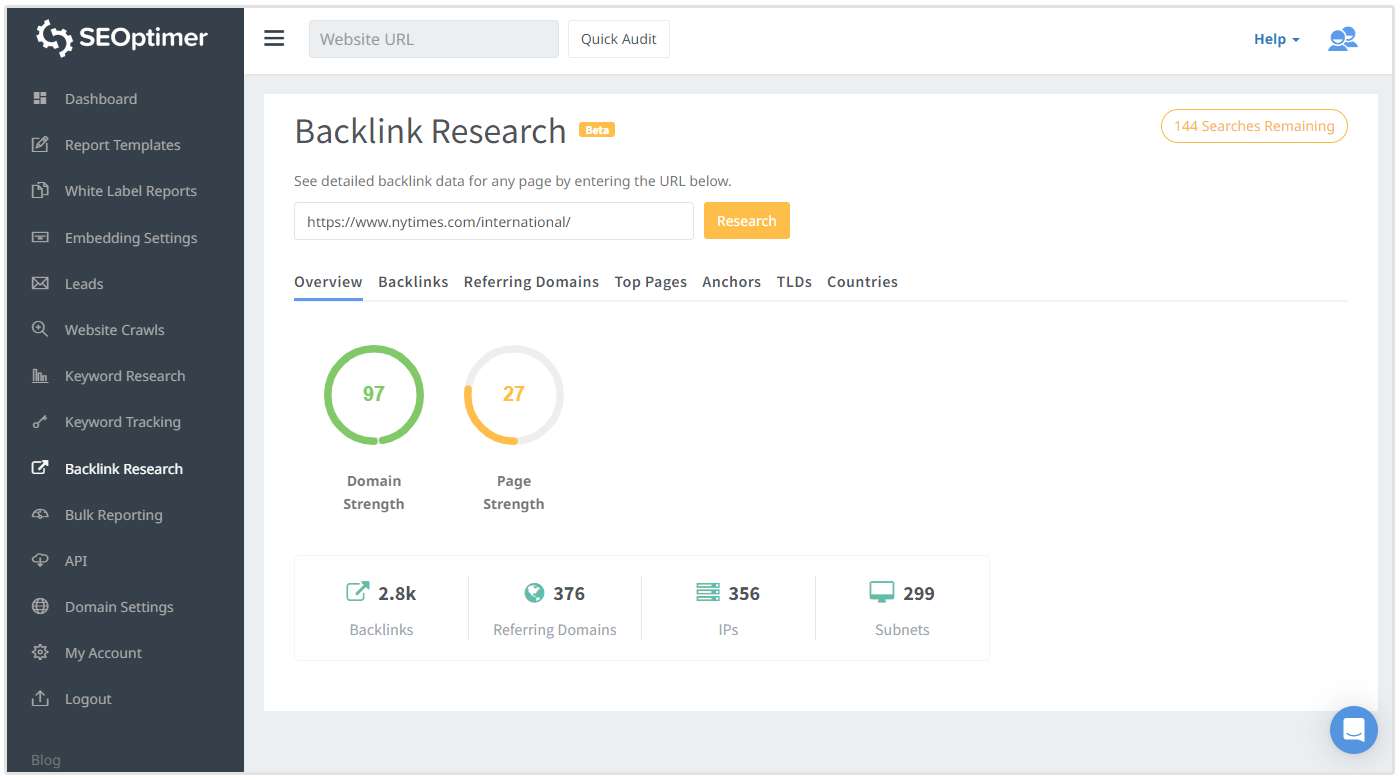
But don’t disregard a new, low-DA website just yet.
You don’t need to get rid of backlinks from low Domain Strength sites, since they can still be helpful to your site, but you’ll want to shoot for higher Domain Strength sites when you’re actively building new links.
Nofollow Versus Dofollow
By default, backlinks are “dofollow,” which means they pass link juice and can influence rankings.
On the other hand, if you want to instruct Google to not give value to a link, a “nofollow” attribute is applied:
<a href=”example.com” rel=”nofollow”>Sample text</a>
Backlinks from social media, blog comments and Wikipedia are all nofollow.
When accepting sponsored or paid links, website owners are required by Google to disclose the partnership and add a nofollow tag to those links.
Since dofollow links provide more value from an SEO perspective, many people try to build only dofollow links to improve their SEO.
However, gaining only dofollow backlinks can look unnatural to search engines, and nofollow links can also indirectly influence rankings.
For example, a nofollow link from a popular website is a good way for your website to get discovered. The right nofollow links can generate tons of valuable referral traffic.

As your brand gains traction, people who recognize and love your content will naturally link back to you, giving you a healthy variety of backlink types. People trying to game the system tend to only focus on dofollow links, so Google is more suspicious of an imbalance in link types these days.
To look good in the eyes of Google, balance is the key. A combination of dofollow and nofollow links is perceived as more natural.
Location of the Link
Contextual links refer to backlinks placed within an article.
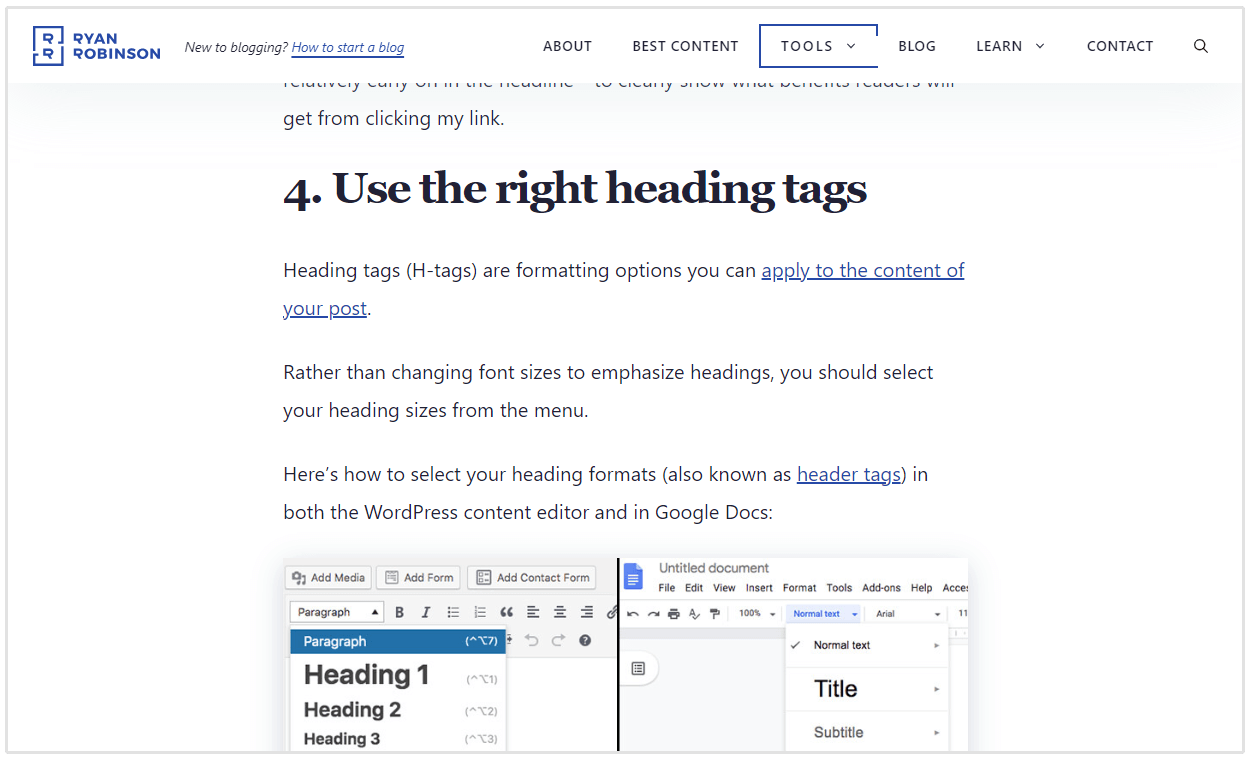
They have more SEO value than those in the footer or sidebar since they’re easily clicked by readers who are eager to know more. This leads to lower bounce rate and positive relevancy signal for your website.
In addition to that, contextual links are relatively more difficult to get.
They’re given to those who not only provide excellent content but who also build genuine relationships with site owners or editors.
Anchor Text
Anchor text is the clickable word or phrase used to link one page to another.
It may contain one of the following:
- Exact keyword (exact match)
- Keyword along with other texts (partial match)
- Name of the website (branded)
- URL of the website (naked URL)
- Generic words like “click here”
Since keywords in the anchor texts suggest what the linked page is all about, they can significantly influence rankings. The downside, however, is it’s very easy to overdo it, putting your site at risk for penalties.
The key is to not use exact match keywords on anchor texts all the time. You want Google to look at your links and never notice any sign of manipulation.
But how much is too much?
Although there’s no standard rule, the following chart showing industry averages will give you an idea of how to achieve balance when using different anchor texts.
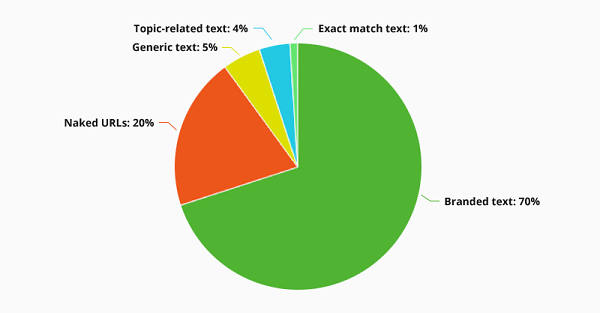
Image source: MarketingLand.com
Using Backlinks to Rank in the Top 10
The primary goal of link-building is to rank high in Google search results.
And by “rank high” I mean, have your content appear on the first page of Google’s search results for a query. To take that one step further, we want our content to be at the top of the first page, ideally in the first three spots.
For example, if I’m optimizing my content for “the best smartphones” into Google’s search bar, I would want my content to fall here.
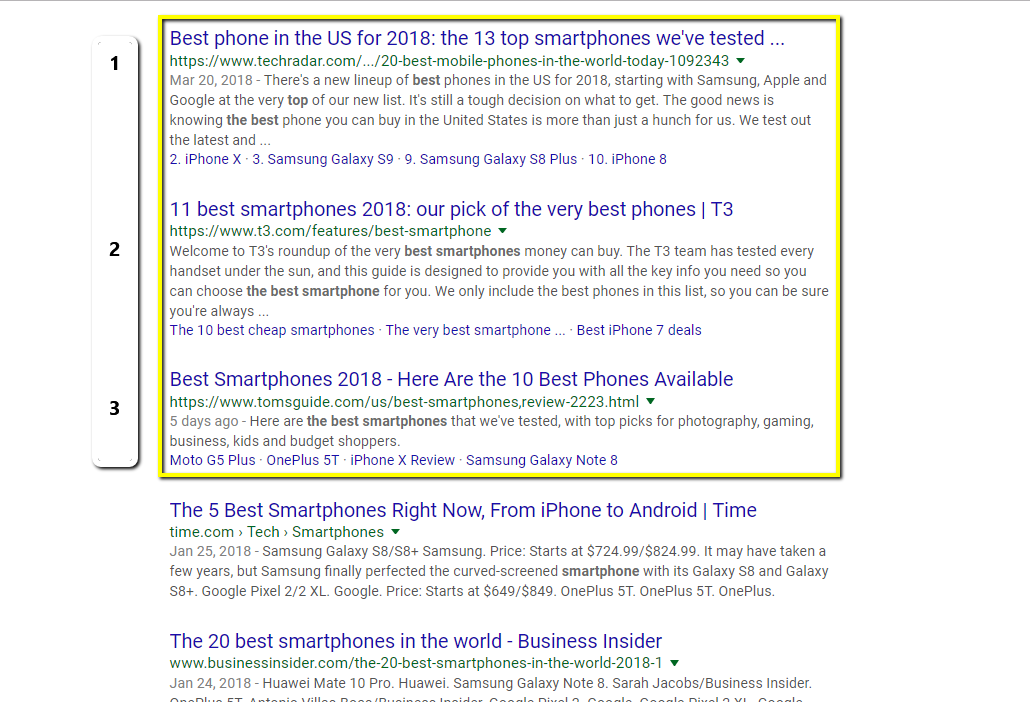
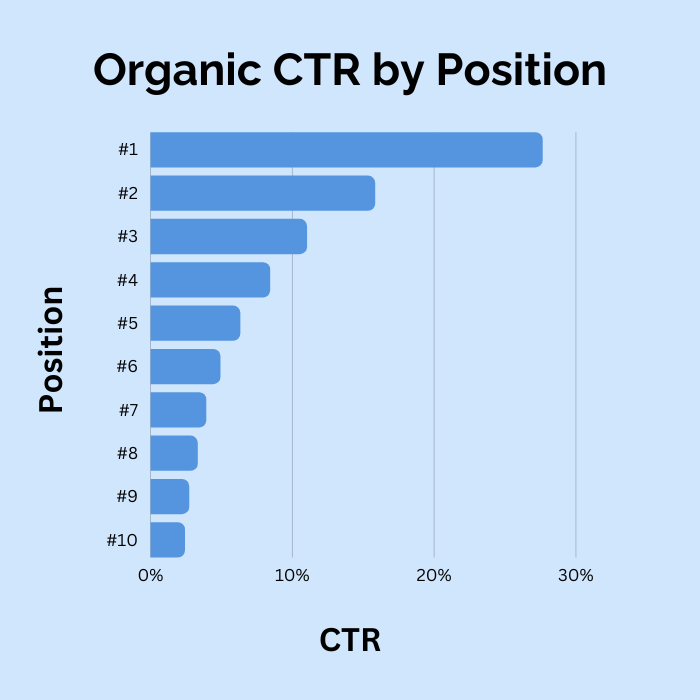
Needless to say, as a marketer, you don’t want to go anywhere but Google’s first page. And if you think you can get there without the help of backlinks, you’re in for a rocky ride.
Backlinks remain a crucial ranking factor that will push your website to Google’s first page—and keep it there.
Your journey, as with any type of business, starts with getting to know the big guys you want to beat. Here, you’ll learn how to score backlinks that improve your rankings.
Step 1: Size Up Your Competition
The top 10 search results are there for one reason. They’ve done something that the rest of the bottom feeders haven’t.
For this reason, you don’t have to reinvent the wheel. Your goal is to decipher whatever strategies they used to get to top spots and replicate them.
Start by Googling your target keyword. Say, you want to dominate the search results for the keyword “how to get rid of lower back pain.”
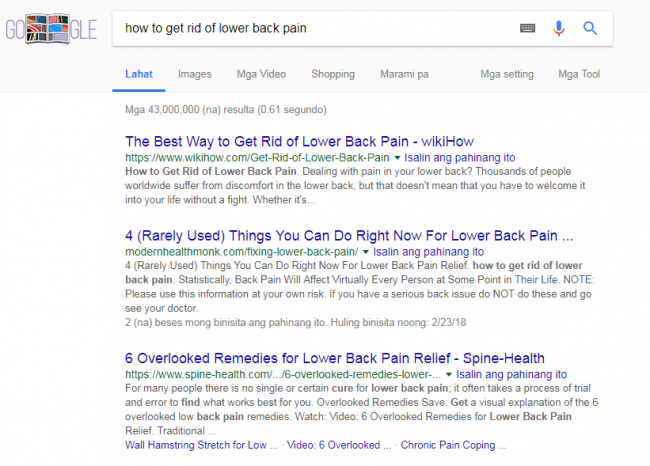
Apart from the content, these websites dominate Google for this specific keyword because of their SEO strategies and, in particular, their backlinks.
To identify which websites are linking to these pages, you need to get their URLs and perform a thorough backlink analysis.
Step 2: Spy On Your Competitor’s Backlinks
The only way to outrank your competitors is to put their link profiles under a microscope and replicate the backlinks that propelled them to the top.
Let’s say you want to see which websites are linking to your top three competitors. Copy their URLs from the web browser.
Go to SEOptimer and click “Backlink Research” from the main menu, then click add the URL of your competitor and click on “Research.” Do the same for the remaining two competitors.
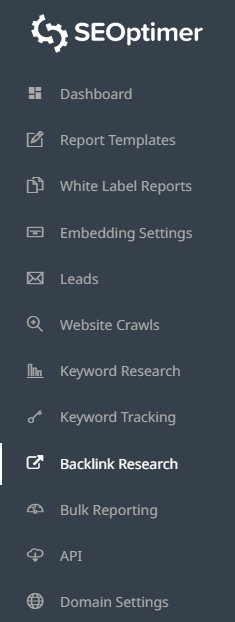
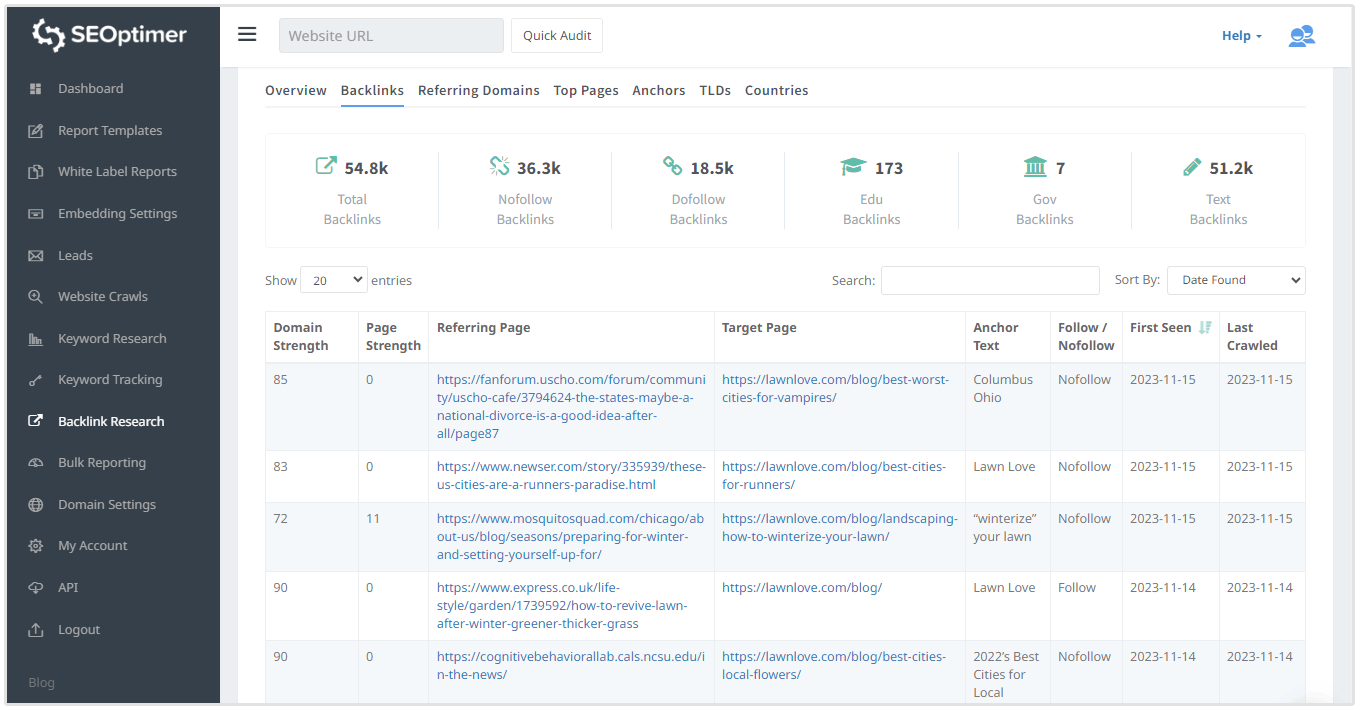
SEOptimer will show you the list of their backlinks, including the Referring Page’s Domain Strength, Page Strength, anchor text, and the type of backlink (nofollow/dofollow).
Steer clear of spammy links and only focus on good backlinks that you can replicate.
Examine the chosen links one by one. Find out whether it’s in a sponsored post, placed within the content and what anchor texts are used.
You don’t have to replicate all backlinks.
Just pick the most authoritative links for each website, ones with high Domain Strength (>30).
Now, you’re ready to do some outreach and score the same quality backlinks as your competitors.
Hold on, one second. You can’t move forward with link building if you have nothing on your website worth linking to, or if you have technical issues that can drive potential linkers away.
So first, we’ll help you prepare your website for a linkbuilding campaign.
Preparing Your Site for Link Building Campaigns
Success in link building starts in your own backyard.
If your website is too slow, difficult to navigate and suffering from serious technical errors, your visitors will run away and never look back.
Google takes notice and will use the negative user experience to prevent your website from ranking.
Even the best link building tactics won’t be enough to compensate for poor website content and structure. By following the strategies below, you’ll prevent link juice from leaking and get the best ROI from your link building campaign.
Speed Up Your Website
People looking for answers on a search engine have shorter attention spans than goldfish.
Your readers aren’t willing to wait more than five seconds for a page to load. If you have a slow website, users will avoid it like the plague even if you’re lucky enough to rank on the first page.
As soon as they hit a page that doesn’t load instantly, they back out.
So, to test your website speed, access Google PageSpeed Insights Tool.
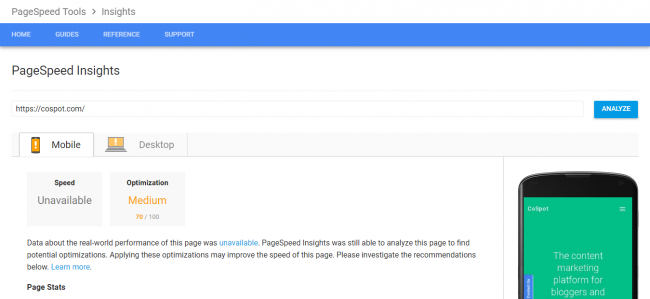
Fix Technical Errors
By plugging the holes in your website’s links, you’ll be able to prevent authority and link juice from leaking.
To identify these errors, I recommend using Google Search Console.
Once you’ve added your website, you’ll be notified via email of any technical issues. You can also go to “Crawl Errors” and get an overview of existing page errors that need your attention.
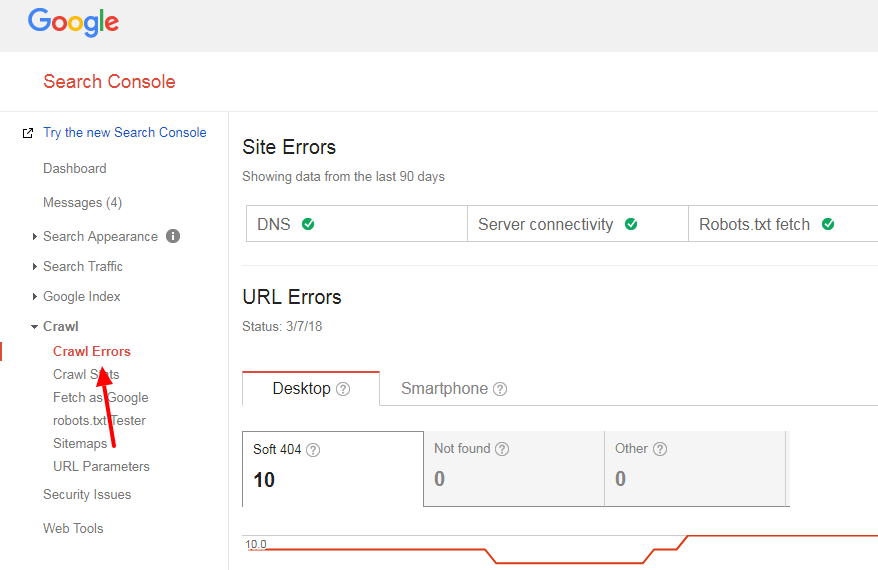
302 Found
This is a bad redirect because it only tells Google that a page has temporarily moved. Hence, Google will ignore it and the link won’t pass any authority or SEO value.
Change it to 301 redirect so Google can follow the new page and restore all the backlinks it earned previously.
404 Not Found
This error code appears when the link leads to an empty page, resulting in negative user experience. To fix this, you can either create a new page or 301 redirect to an existing page.
Improve Site Architecture
The more organized your site architecture is, the easier the link equity or link juice will be distributed through your site.
To achieve this, you need to create a silo structure.
Silos are a way of taking your main idea or keyword and breaking it down into different categories. It allows you to go deep into a topic and answer all possible user queries related to your niche.
As opposed to the traditional blog structure where the blog articles are arranged according to date, a silo is more logically organized and enables Google to index your site easier.
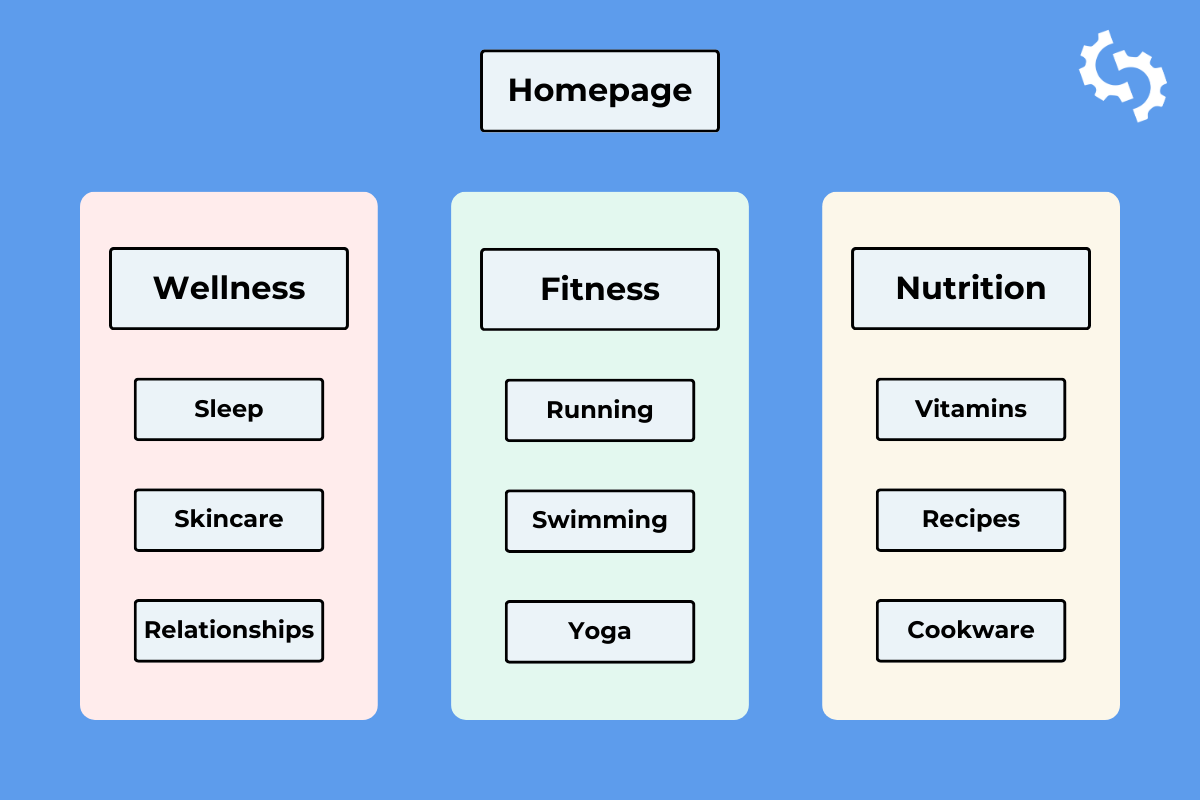
Let’s say your blog is about general health.
You can create different categories out of this main idea like “wellness” and “nutrition.” These categories can branch off into more subcategories like individual product reviews and informational pages.
Meanwhile, as you start building backlinks, the reverse silo works best.
Basically, you’ll write an in-depth article that is purely informational and linkworthy. This is what you’ll use for your link building campaign.
This blog article which receives all the backlinks will then distribute the link equity throughout your website through internal links.
Invest in Linkable Assets
A linkable asset is just like that. It’s a page or series of pages that are irresistible, that must be shared, such that other websites in your niche will readily link to it.
Others call it link bait, but this term tends to connote something controversial, deceptive or unethical. I prefer to call it a linkable asset because it really is an asset that will help you gain backlinks no matter how dry or boring your niche is.
A linkable asset shouldn’t necessarily be limited to in-depth articles. It can also be a well-designed tool that your target readers will find useful, like CoSchedule’s free headline analyzer.
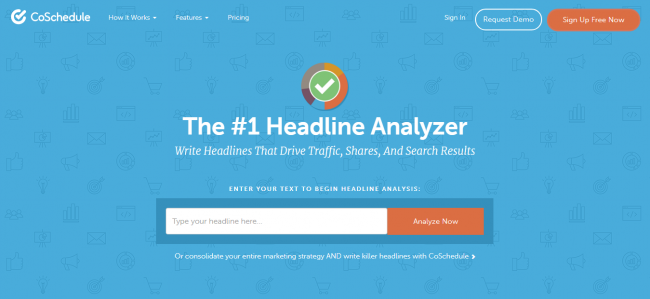
The idea is to find sites ranking for your target keyword, examine their contents and outperform them by creating something even better—something more comprehensive and unique.
The first step is to find what your competitors are up to. You can do this with simple Google search of your target keyword. If you want more detailed information, go to BuzzSumo and enter the keyword.
Let’s say you want to write content based on the keyword “content marketing.” BuzzSumo will show the most popular pages for that keyword as well as their backlinks.
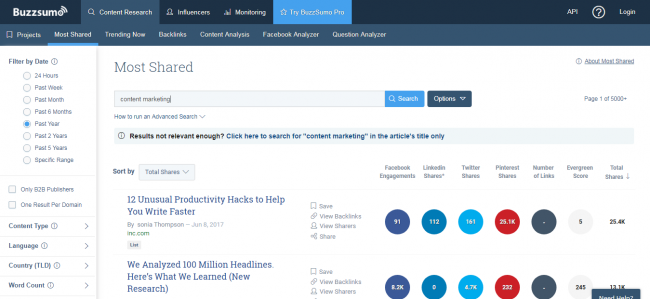
Create a better content by adding a unique twist, writing a longer article or surpassing your competitors in terms of design.
The goal is to make your linkable asset stand out so when it’s time to replicate your competitor’s backlinks, you’ll have a higher chance of convincing site owners to link back to you.
Link Building Strategies
Building backlinks takes a lot of time. But seeing the results of your link building efforts takes even longer.
Hence, it’s crucial to focus on link building tactics that drive results from the get-go instead of wasting time on things that barely influence rankings.
For its state of link building report, Moz conducted a survey involving link builders with diverse backgrounds. While the results are nothing conclusive, it provides insights on which link building strategies are the most effective.
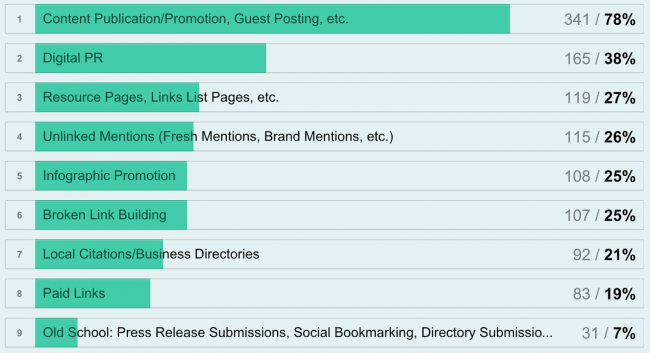
Let’s take a closer look at the tactics that seasoned link builders think are most effective:
A. Guest Posting
Guest blogging is far from dead.
Granted, someone from Google announced in 2014 that the glory days of guest blogging are over. But the statement only applies to low-quality guest blogging.
You know, those random guest bloggers with fake identities asking for links in exchange for money.
It’s a blatant violation of Google’s quality guidelines which clearly prohibit “buying or selling links that pass PageRank.”
But all hope is not lost. Matt Cutts followed up the announcement with this reassuring message:

From his statement, we can infer that:
- High-quality guest blogging is still alive and well.
- It remains an effective way to promote your website or services.
- The goal of guest blogging should be to build genuine relationships, not just acquire backlinks.
The best part about guest blogging is it can potentially bring results as soon as the backlink goes live.
In contrast to advertisements which are trying to shove products down people’s throats, guest blogging is an inbound marketing strategy which uses content that resonates with your target readers.
So when these readers like your content and click the link to your site, they're more likely to buy your product or at the very least, subscribe to your email list.
But what exactly is a high-quality guest blogging and how can you do it?
Step 1: Make your guest blogging “hit list.”
Find all authority blogs in your niche by using one of these search strings:
Niche + guest blog
Niche + guest post
Niche + contribute
Niche + write for us
Let’s say you have a blog about hair loss. By typing in “hair loss + write for us,” Google shows me related websites in my niche that accept guest bloggers.
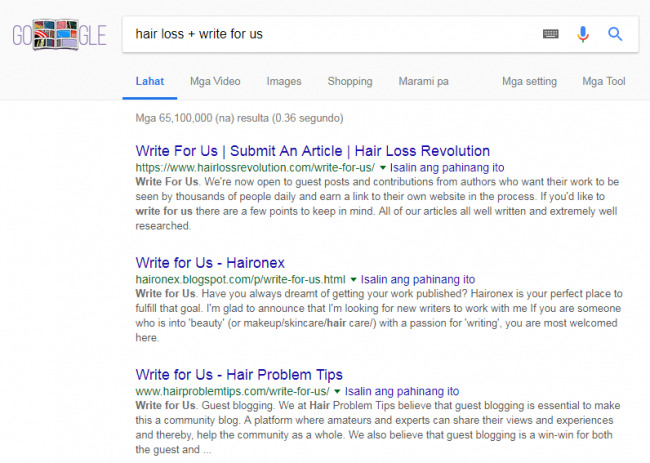
Site:domain.com “guest post by”
Site:domain.com “submit a guest post”
Site:domain.com “become a contributor”
Site:domain.com “contribute an article”
Thoroughly review each website you find and look for the following quality signals:
- Domain Authority (DA) of at least 30. DA is a ranking metric by Moz which assigns websites with scores ranging from 0 to 100 depending on how likely a backlink from them can boost your website’s position in Google. Links from websites with DA 30 or higher can move the needle faster than new websites with lower scores.
- Guest posts with outbound links that are dofollow and with anchor texts within the content. However, you can still write for sites that only allow nofollow links as long as they have engaged readers and huge social media following. If you’re not getting links with SEO value, at least aim to get as many eyeballs as you can to your website.
- Social media shares and blog comments, both of which provide insights into how popular the website is. You can tap into this community to boost your own readership or email list.
Step 2: Send them an offer they can’t refuse.
Keep in mind that when you’re sending your pitch, your goal is stand out from others trying to do the same.
As a site owner, I’ve also received tons of emails from link-hungry marketers. Although they’re annoying as hell, they have taught me a lot of lessons on how to do email outreach the right way.
Before anything else, you need to look for the following to ensure guest blogging success from the get-go:
- Editorial guidelines for guest bloggers.
- Name and email address of the site owner.
- Links to your guest posts on popular websites.
Let’s use Neil Patel’s guest post email template as an example.
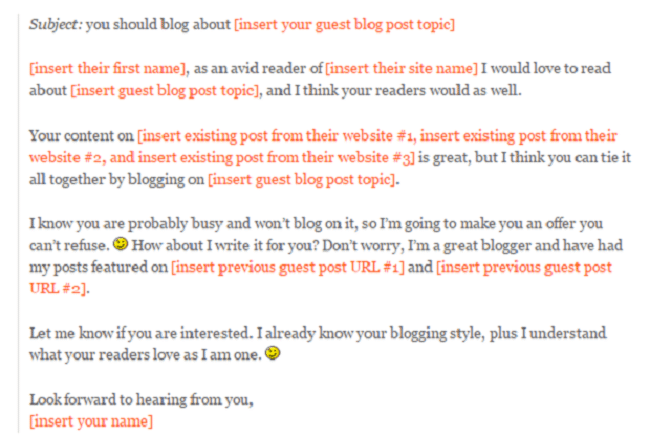
Here are the reasons why his email template works:
It’s personalized.
I can’t count how many times I’ve deleted emails beginning with generic “Good day,” “Hello” or “Dear webmaster.” No matter how awesome your proposed content is, your email will likely go straight to the trash folder if you don’t do your homework. Failing to get an information as simple as the site owner’s name reveals how lazy you are and how much you’re relying on sheer luck to get backlinks.
It’s short and sweet.
Cut all the fluff and let the site owners know the purpose of your email in as few words as possible. Prove that you’ve read their articles and show what you can bring to the table. Remember that before opening emails, site owners always ask “What’s in it for me?” Make it all about them. Highlight the benefits they’ll get from your guest post and I guarantee your response rate will go through the roof.
It reduces resistance through social proof.
By showing the links to guest posts you’ve written for popular websites, you’re proving that you can deliver. Choose articles from your portfolio that are not only well-written but have also generated high social media engagement.
B. Digital PR
Digital PR and guest blogging overlap with each other in many ways. But while the latter mostly focuses on getting backlinks, digital PR differs in two ways:
Relationship-building is at its core.
Ever wondered how some people are able to contribute or get links from big publications like Fast Company or Forbes? The key to making it to these high-DA, high-traffic websites isn't in the hands of its founders but of the very people who provide content for them—journalists, editors, reporters.
Digital PR is about building long-term relationships with these folks.
Since most of these reporters/writers are on Twitter, your skills in media relations may involve interacting with their tweets regularly.
Remember, you’re doing this as a warm-up before sending your pitch. And a warm pitch is always better than a cold one.
Brand awareness first, backlinks second.
The aim of digital PR is to get your message in front of as many people as possible. It doesn’t matter if the backlink from these big publications is nofollow or dofollow—it’s the long-term benefits of the link that count.
For instance, your article published in Forbes may have backlinks that initially have no SEO value but the popularity it can gain through social media may eventually lead to organic backlinks.
In a nutshell, digital PR is guest posting with a purpose. You can start your own digital PR campaign with these few steps.
Step 1: Know your objective.
What exactly is the reason why you want media coverage? Whether it’s to build awareness around your newly launched product or as simple as increasing your email subscribers, it’s important to know what goal you want to fulfill.
Step 2: Find a newsworthy angle to your story.
What about your product or company that will intrigue reporters enough to give the spotlight to your story?
Find a convincing angle that will ensure your pitch won’t end up in somebody’s trash folder. For example, if you have a startup that helps freelancers with their taxation woes, don’t just explain what it’s for.
Share a compelling story. Create a video, infographic or blog post about how it all started. If it’s your personal experiences that inspired the idea, highlight it.
Give the journalists something noteworthy to talk about.
Step 3: Establish rapport with journalists/reporters ahead of time.
Connect before you pitch. This is the unwritten rule of digital PR.You can take shortcuts by cold pitching but the chances of you getting noticed are slim to none.
Between someone who took time to connect with me and a stranger who appears out of nowhere with his pitch, I’d gladly respond to the former in a heartbeat.
And I’m not alone in this: 64% of writers believe that establishing a personal connection is a must before making a pitch.
Make it your goal to start engaging with journalists or writers at least three months before sending them your pitch.
Aside from the traditional in-person networking, Twitter is also a goldmine of media connections. In fact, almost 60% of writers have Twitter accounts.
Get them to notice you by following their Twitter profiles and consistently engaging with their tweets.
Reporters are also on the lookout for great stories. Through HARO (Help A Reporter Out), you can provide them with leads. By extending your help with no strings attached, they'll likely be more than happy to return the favor once it’s your turn to ask for help.

Step 4: Make a winning pitch.
By now, you’ve already built a relationship with the press. You also know what type of content the journalist you’ve kept in touch with usually covers.
Ensure that your pitch perfectly aligns with the core message the journalist or the publication is known for.
For example, if the online magazine the reporter is writing for features entrepreneurial success stories, make sure your pitch revolves around this theme. Prepare a press kit containing all the information about your or your product.
If your pitch gets rejected, ask for feedback and explore how you can make it better. Rejected or not, don’t stop cultivating the relationship you’ve already built.
You can use this connection to build even more connections that will help you in your future endeavors.
C. Resource Pages
A resource page is a list of links to recommended contents that website owners think will be of great help for their readers.
They're great sources of backlinks for three reasons:
- They're often in the same niche as your website and links out to other relevant sites.
- Resource pages explicitly ask for link suggestions. This means you don’t have to think of low-key and sometimes deceptive ways to get backlinks. These pages are begging for links and all you need to do is prove your page is worth including.
- The backlinks are placed within the content.
Sounds easy, right?
But to succeed in this method, you should have a working knowledge of which resource pages are worth your time and attention. Here’s how to do it right.
Step 1: Collect and select.
Check if there are existing resource pages in your niche. Some popular niches have plenty of pages to choose from while the more obscure ones may need advanced methods of research.
Go to Google and use any of these search strings:
“Keyword” + inurl:links
“Keyword” + “useful resources”
“Keyword” + “useful links”
“Keyword” + “helpful resources”
If I have a hair loss blog, for example, I can type in "hair loss" + inurl:links and these results will show up:
The first result leads me to HairDirect.com resource page containing links to some of the best websites that deal with the subject of hair loss.
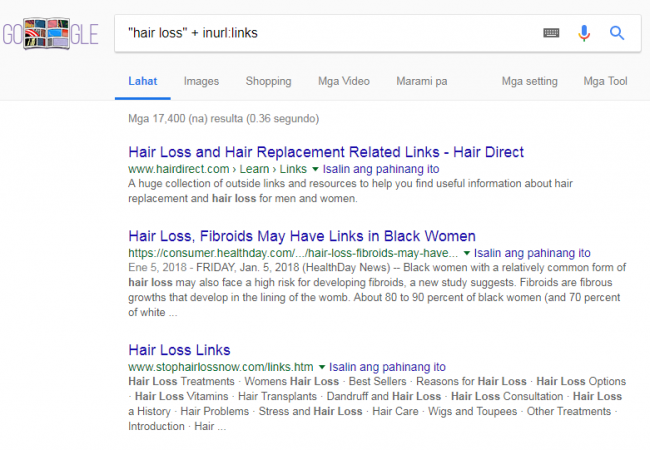
To judge whether a backlink from this resource page is worth pursuing, I look for the following:
- Domain and Page Authority. These metrics developed by Moz will give you an idea how authoritative the website is in its niche. The higher the scores are, the more likely a backlink from the website can influence your rankings. In my example, HairDirect.com has a DA of 37 and PA of 44.
- Request for links. You’re more likely to get a backlink from resource pages directly asking for it than those that don’t. In the case of HairDirect.com, you can find at the bottom of the page an invitation to get your website featured on its resource page as well as the website’s email address. These suggest they’re willing to give you a backlink as long as your content meets their standards.
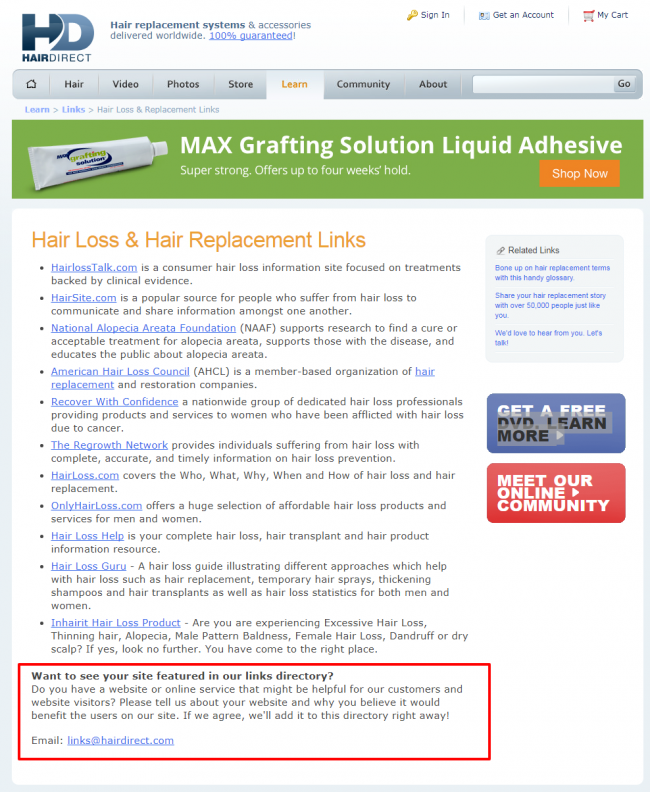
Step 2: Request for a link like a pro.
Cold emails have always been associated with atrocious open rates.
Although you can use one of several templates on the internet, I recommend that you shy away from this ready-made rubbish and write your own. Take note of the following pointers:
- Know more about the website, what it’s for, and how much related it is to your own page.
- Use a private email address rather than a free Gmail account commonly used by spammers.
- Address the site owner in his/her first name.
- Keep your message short and sweet. Don’t bore them with blocks of text. Briefly state why you emailed. Include a link to the resource page and another to your website/page with a convincing explanation why it’s worth linking out to.
D. Unlinked Mentions
This strategy mostly applies to websites that have been around for a while and whose names are already recognized in their niche.
Link reclamation is the process of getting backlinks from sites that have mentioned your name/keyword/brand in their articles but somehow forgot to link back to you.
You’re not starting from scratch but merely reclaiming links that are already yours.
To find unlinked mentions, you can use the following search string:
“keyword/brand name/person name” -ownsite.com -twitter.com -facebook.com -google.com
The keyword is enclosed in quotation marks so Google will only show results that are directly related to your keyword.
You can also use Google Alerts to send you an email notification once daily or weekly every time your name or brand is mentioned.
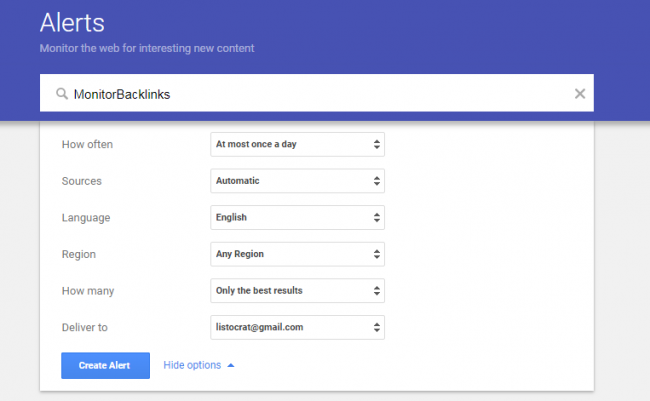
If you want to specify the source of the mentions you want to get notified for, go to Sources and choose blogs, news sites or any other type of site from the drop-down list.
Only choose legit websites with non-spammy content, high Domain Authority, and high reader engagement. Once you’ve found enough unlinked mentions, send each site owner an email requesting for the backlink.
Most of them won’t hesitate to add a hyperlink if you mention the benefit of doing so like “if you add this link, your readers won’t have to go to Google and search for the URL on their own.”
Keep the message simple and non-confrontational. If the site owner hesitates or has a reason for not linking out, move on to other sites.
E. Infographic Promotion
Infographics can turn even the most boring information into colorful, shareable eye candies. And the fact that 90% of information coming into our brains is visual only prove one thing: It’s in our nature to favor graphics over texts.
Should you join the infographics bandwagon? Absolutely. According to Hubspot, infographics are three times more likely to be liked and shared than any other form of content.
The not-so-bad news is the use of infographics as a marketing tool somehow reached its tipping point in 2012. To stand out in a sea of mediocre infographics, you can emulate what big-budget companies are doing: Creating alternative forms of visual content like maps, 3D mockups and interactive visuals.
Of course, the old-fashioned infographics can still work especially if you’re a beginner on a shoestring budget.
These are the steps you need to take for a successful infographics promotion.
Step 1: Gather the data.
Brainstorm possible topics that you can turn into a shareable visual content. To get ideas, you can search for the most popular infographics in your niche through BuzzSumo or Pinterest.
For example, when I entered the keyword “hair loss infographics” on Pinterest, I found this simple yet engaging infographic which can serve as an inspiration for my own art:
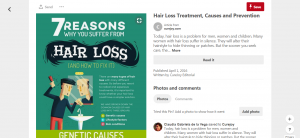
When you’ve chosen the topic to discuss, add meat to your content by getting information only from trusted, authoritative sites in your niche. You can also gather key information through interviews, surveys and scientific journals online.
Write captivating title, sub-sections and captions for your infographic. Keep them concise but not too short that they leave out essential details.
The texts should transition smoothly and can tell a story even without the graphics.
Step 2: Delegate the design process.
If you have limited design skills, it’s only wise to pay a professional to design the infographic for you. A decent designer in Upwork can cost at least $200.
Provide all the information that the designer needs, including the design elements you want to see like charts, icons, graphs, color palette, illustrations or animations.
As with the writing, the graphics or images should be able to flow smoothly and tell a story on their own.
You can draw inspiration from highly shared infographics on Pinterest. The popularity of these infographics suggests they have elements that people love and you should emulate.
Step 3: Promote, promote, promote.
When uploading your infographic on your blog, don’t forget to include an embed code so readers will be able to share it on their own sites. There are several embed code generators online that you can use for this purpose.
Once the article containing the infographic is published on your blog, it’s time to use your art to get backlinks. Here are few ways to do it:
- Guestographics. A strategy popularized by link building guru Brian Dean, it involves reaching out to relevant websites to secure guest blogging opportunities. But instead of writing a traditional guest blog, you’ll convince them to publish your infographic along with a short introduction which you’ll provide.
- Social media. Infographics get the most traffic from Pinterest where users keep “repinning” images even years after they were first published. Include relevant hashtags to boost the chances of your infographic getting discovered.
- Infographic directory. By submitting your infographic to one of these websites and directories, you will be able to increase its reach and boost both your SEO and social signals.
Further Reading: How To Build Quality Backlinks With Infographics
F. Broken Link Building
As the world wide web continues to grow and websites undergo redesigns, more and more broken backlinks are created.
Broken backlinks are never good for SEO. From a user standpoint, a link that leads to a 404 error page can be a huge downer. If you want to bring a positive user experience, then you should replace these broken links with ones that work.
Broken link building hinges upon the desires of webmasters to ensure all their links are working. Basically, it involves three steps:
- Prospecting or finding out if a website has existing broken links. A Google Chrome extension called Check My Links can help you in this task. It will run all the links in a page and highlight those that are broken with red.
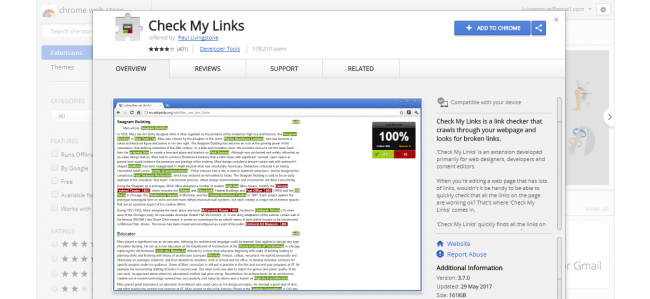
- Content which involves filling up the gap brought by the broken link. For example, if the broken link is pointing to a missing page about “hair loss vitamins,” you'll either find a page in your website about the same topic or write a new article from scratch.
- Outreach where you’ll send an email to the webmasters, letting them know about the broken links, and convincing them to replace the link with one pointing to the new resource you just created.
Broken link building is a win-win situation: You get to fix someone else’s broken link and earn free backlink in return.
G. Local Citations/Business Directories
Backlinks from business directories will give your local business the online visibility it needs to prosper.
These listings, similar to the old-fashioned yellow pages, provide your potential customers a way to contact you. They’re also the best place for them to give feedback, make comparisons and know more about your business.
For every popular directories like Yelp, Yellow Pages and Merchant Circle, there are even more relatively obscure sites that offer free or paid listings.
Before signing up to any directory, it’s best to observe due diligence.
Use Alexa to find out how much traffic it generates per month and where most visitors come from. You don’t want to add your US-based business to a directory where the bulk of the traffic comes from India.
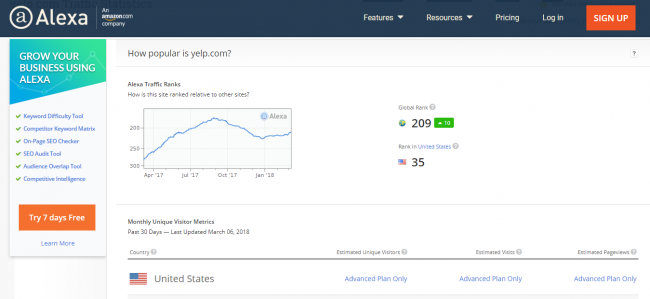
When finding the best business directories, quality always trumps quantity.Here are few choices I recommend:
Directories already ranking for your business.
In this type of directory, the name of your business has already been added albeit with an empty page. It’s already ranking and all you need to do is fill in more details about your company like email address, contact number(s), business hours, link to your website and photos.
Directories featuring your competitors.
If you search the name of your competitor and the results include directories you’re not a part of, you’re missing out on a potentially great source of traffic.
Examine your competitor’s profile and if it has a complete information about their company and has numerous feedback, you should definitely sign up to this directory.
Directories ranking in mobile search.
50% of mobile searchers end up visiting the local store they find so your absence in mobile search results spells serious profit loss.
Directories ranking for your main keywords.
If you find directories ranking for your target keywords, don’t hesitate to add your business to their listings. By doing so, you increase the likelihood of your business being discovered either through Google search or from the directories you sign up to.
G. Other Linkbuilding Strategies
The link building tactics discussed in this section are either too risky or relatively ineffective compared to other strategies discussed above.
However, as long as you follow the best practices in building these backlinks, they can help diversify your link profile.
At the end of the day, backlinks that come from different sources always look more natural--and less liable to Google penalties--than those originating from a single source.
Paid Links
Bloggers who charge a certain fee in exchange for backlinks are not unheard of these days. In fact, they're the most common webmasters you’ll encounter when doing outreach, second only to those who never respond to your emails at all.
But while it sounds easy to do, there are three reasons why you should steer clear of paid links:
It’s risky.
There are three types of backlinks based on the kind of method used to acquire them: white hat (ethical and penalty-proof), gray hat (a little bit risky), and the black hat (too risky and violates Google’s quality guidelines).
Paid links are reeling between gray and black hat as they are a perfect example of what Google guidelines describe as manipulative link scheme.

Even if you acquire the link privately, Google’s increasing use of artificial intelligence to weed out unnatural links will see this method becoming more ineffective in the near future.
It’s expensive.
Webmasters can charge anywhere between 50 USD and 500+ USD for a single backlink.
The lower the domain authority of the site, the lower the fee. And yet, this is just for one backlink with no guarantee of it influencing your ranking.
Rather than spending cash on a risky technique, you can get more backlinks by providing value through guest posting. When paying for a single backlink, you are actually paying for the time it would normally take to get more backlinks the natural way.
So save up your cash and just start hustling.
Your links are in bad company.
If someone readily accepts your cash in exchange for a backlink, don’t you think that person will do the same to anyone asking for links?
As a result, the backlink pointing to your site will be placed among other links to questionable sites that Google frown upon.
Although your website is legit, it’s possible that Google may penalize it by mere association to these bad websites.
Press Release Submissions
The use of press releases to earn backlinks has earned a bad rap over the years. But it’s not because press releases are nefarious by nature but due to marketers who have used it as a vehicle to spam the internet with low-quality links.
However, it can still work, albeit minimal, in promoting your website. Make sure you have something noteworthy to share (e.g., a groundbreaking online tool or a product launch) then write a press release about it.
If you don’t have experience writing a press release, you can hire a freelancer who knows the specific style required for it. Then, submit it to press release distribution networks like PR Newswire.
The cost to distribute press releases may range from 100 to 200 USD but it can be a great investment if your story truly stands out.
Social Bookmarking
Submitting links to sites like Reddit, Digg and StumbleUpon don’t drive as much referral traffic as they used to. If anything, they only increase your website’s bounce rate, especially if you only casually use these bookmarking sites for promotion.
There’s no harm in using social bookmarking sites as long as you don’t spam them with links.
For better results, only choose bookmarking sites that suit your target audience. For example, a recipe or wedding blog may be better off engaging audience in a platform rich in visual contents like Pinterest.
Directory Submissions
Directories collect links to different websites and organize them into various categories.
The problem with directories is they don’t provide real content that offers value to readers. Most of them were built for the sole purpose of building backlinks.
Worse, the line that separates good and bad directories is hazy at best, proven by Google’s crackdown on these sites in 2012 which will most likely continue in the years to come.
Part V: The 5 commandments of link building
Diversify Your Link Profile
In a 2016 case study where 1 million Google search results were analyzed, Backlinko discovered that getting backlinks from a single source just won’t cut it.
You need to diversify your links because the more unique domains pointing to your site, the higher your ranking will be.
However, this doesn’t mean you can get any link and expect your site to experience explosive growth. Fewer links from relevant, high-authority and high-traffic sites will always be more powerful than 1,000 spammy links.
Use Ego Bait
The law of reciprocity states that if you put someone in a favorable light, that person will likely return the favor.
This is the reason why great expert roundups attract links naturally. The experts featured, quoted or praised will feel so appreciated that they'll gladly promote the article on their social media accounts or even link back to it.
However, expert roundup isn't the only format you can use to mention influencers.
Another way to get their attention is by linking back to them from your articles or infographics then following it up with email outreach to let them know about the mention.
Don't Endanger Your Site with Links from PBNs
The use of private blog network (PBN) continues to polarize the link building community. While some vouch for its effectiveness, others have plenty of horror stories to prove it’s not worth it.
For starters, building a PBN requires a lot of time, money and effort.
It starts with finding expired domains with good link profiles, followed by populating each domain with contents (either from scratch or through repurposed articles).
Each website also requires different hosting, theme, and plugins. Once they’re all ready, you’ll then link all these dummy sites to your “real” website.
Just reading the steps involved in creating PBNs is already exhausting. You can only imagine how much effort it will take to minimize the footprint of all these sites and prevent your PBN from getting caught.
I’m not saying it doesn’t work. As long as you can tolerate the high risk involved in keeping it, then, by all means, give it a try. But don’t you think your limited resources (i.e., time and money) would be better spent on white hat link building that can stand the test of time?
The choice is yours, but with Google’s machine learning gradually becoming smarter, it won’t be long before we see even the most advanced of PBNs getting slapped with penalties.
Track Your Backlinks to Protect Your Website from Negative SEO
Negative SEO is a group of shady tactics aimed at kicking a competitor’s website out of the top Google search results.
Even if you’re too nice to partake in this nefarious strategy, the same can't be said for your competitors who are always ready to outrank you at every chance they’ve got.
You usually know you’re under attack when several low-quality sites start linking to your site at the same time. These unnatural links come from link farms or a group of interconnected sites with spammy contents.
They'll overstuff the articles in these link farms with keywords or use several exact-match anchor texts to mislead Google that you’re manipulating your rankings.
Aside from link farms, other black hat link builders ca










